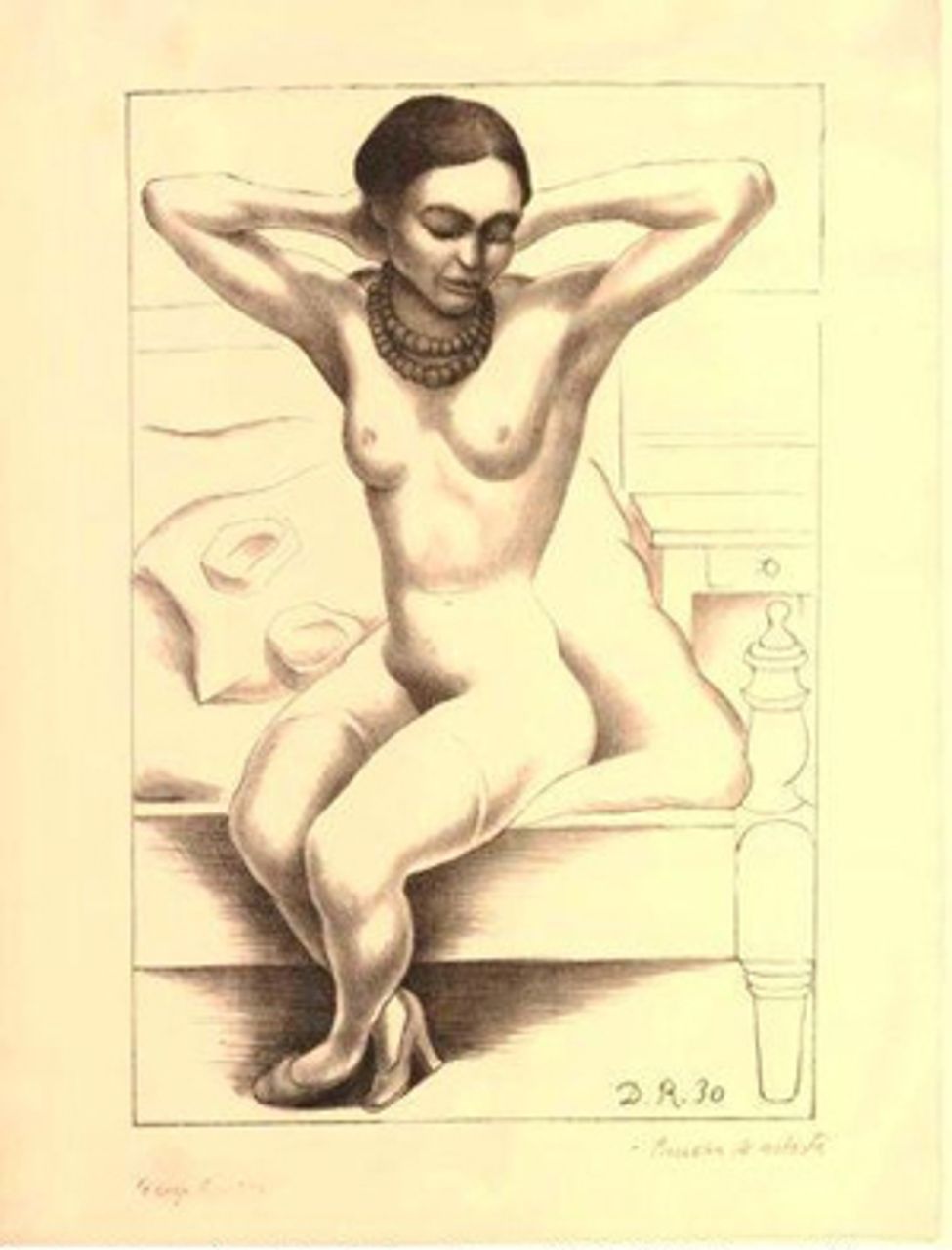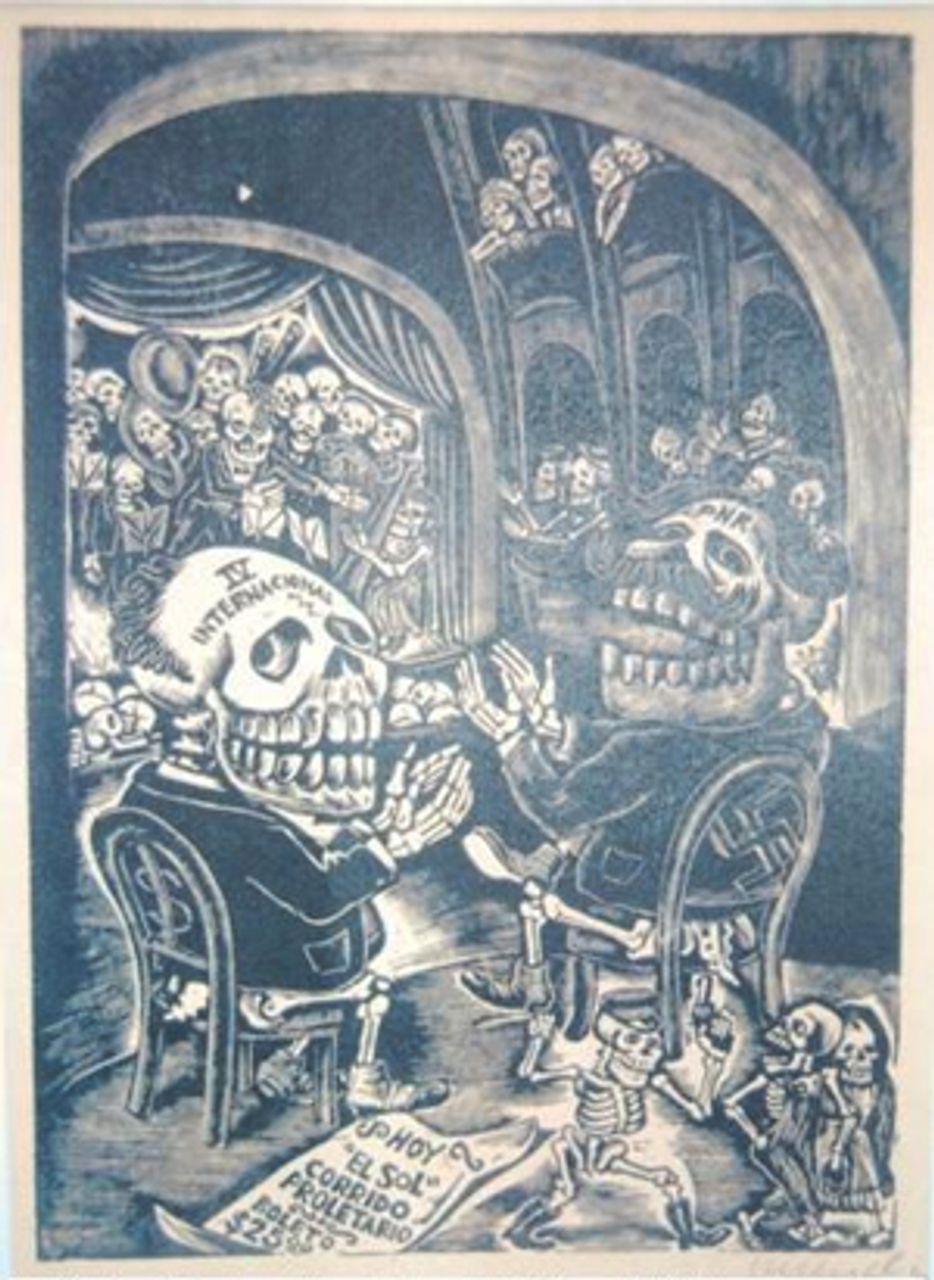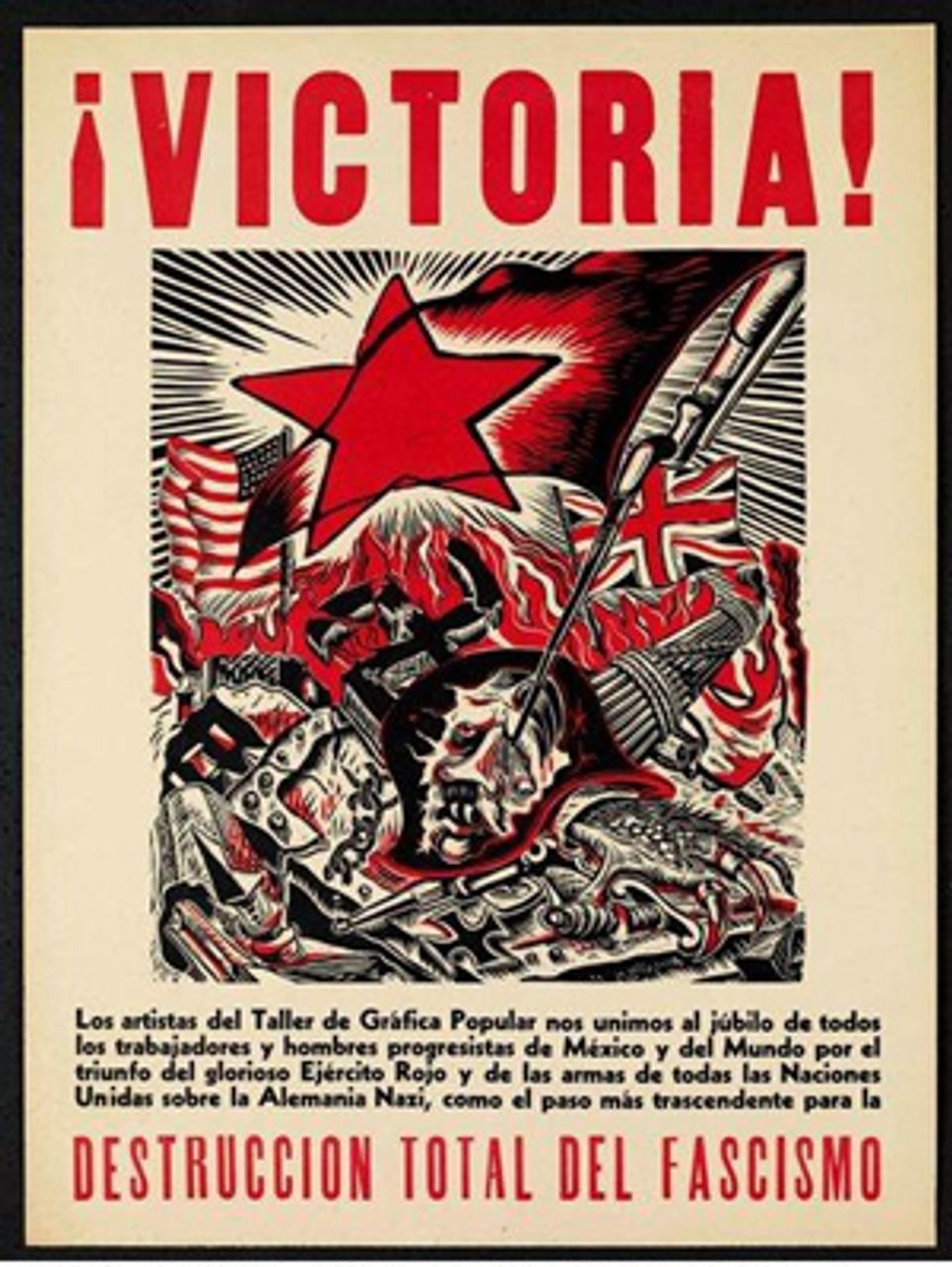Mexican prints 1910-1960 will be shown at the British Museum in London through April 5, 2010.
The current exhibition at the British Museum of Mexican printmaking in the early 20th century is the first ever in Europe. For most people, Mexico is more often associated with one of the leading art forms of Twentieth Century―the huge murals of “los tres grandes” of Mexican art: Diego Rivera, David Álfaro Siqueiros and José Clemente Orozco.
There are a number of interesting and beautiful prints in the exhibition. But it offers a distorted view of Stalinism and its creation, the People’s Graphic Workshop (Taller de Gráfica Popular, TGP). Although the exhibition refers to Trotsky’s exile in Mexico (it could hardly ignore him given the part played by many TGP members led by Siqueiros in the failed attempt on his life in May 1940), there is at best no real understanding of the world historical struggle between Stalinism and Trotskyism and, at worst, a deliberate and essentially pro-Stalinist depiction of that struggle.
 Emiliano Zapata and his horse. Diego Rivera. 1932.
Emiliano Zapata and his horse. Diego Rivera. 1932. © 2009, Banco de Mexico. Diego Rivera & Frida Kahlo
Museums Trust, Mexico D.F. / DACS.
The exhibition catalog starts well, placing the explosion of printmaking in the political developments in Mexico following the 1910-1920 revolution that ended the decades-long dictatorship of Porfirio Díaz. It explains how the movement against Díaz was led by the liberal landowner Francisco Madero, who represented the provincial elites and middle class opposed to Diaz’s subservience to foreign capital. The impoverished peasantry and working class responded to Madero’s call for armed rebellion, producing leaders such as Emiliano Zapata, Pancho Villa and Pascual Orozco. Madero became president in the following year, but reneged on his promises of land reform. He was murdered in a counterrevolution in 1913 as was Zapata six years later.
A triumphant military governor of Morelos declared, “Zapata having disappeared, Zapatismo has died.” But he spoke too soon. Instead Zapata became a folk hero and Diego Rivera’s “Emiliano Zapata,” one of the handful of prints he produced, has become one of the most well-known images in Mexican art. Its origins lie in one of the murals the artist painted in the Palace of Cortés in Cuernavaca, the state capital of Morelos, between 1929 and 1931.
Rivera, the exhibition catalog explains, shows “a modest indifference to hierarchy and the decorum of power: Zapata is one among many, but he is exceptional.” Rivera, a supporter of the Mexican Revolution, the Russian Revolution and also, for a number of years, Leon Trotsky and the Fourth International, portrays a nobility and optimism in his art that is missing from much of the work, affected by the dogma of Socialist Realism, displayed elsewhere in the exhibition. He was profoundly dissatisfied with the reality around him and, while faithfully portraying it, attempted to lift the veil to reveal an ideal future.
 Nude with beads (Frida Kahlo). Diego Rivera. 1930.
Nude with beads (Frida Kahlo). Diego Rivera. 1930. © 2009, Banco de Mexico. Diego Rivera & Frida Kahlo
Museums Trust, Mexico D.F. / DACS.
Also not to be missed is Rivera’s beguiling portrayal of his wife Frida Kahlo.
The year 1921 saw the return to Mexico of Rivera, who had been in Europe for 14 years, and Siqueiros, who had been on the continent for a shorter period. On his arrival, Siqueiros issued a manifesto calling for the restoration of “old values”―the “constructive vitality” of pre-Columbian art of the Maya, Aztecs and Incas―endowed with “new values.”
There was an explosion of other artistic movements. The Stridentists, who were similar to the Futurists, launched their own manifesto in the same year, declaring, “Let’s make a quintessential and purifying synthesis of all the tendencies that have flourished at the maximal level of our modern, enlightened elation.” Then there was the Mexican nationalism-oriented 30-30 group, named after a machine gun popular in the revolution, and the more international-leaning Los Contemporáneos.
The exhibition attempts to show that underlying the eruption of these different artistic movements was a tension between European modern art and “Mexican cultural nationalism.”
There is little mention of the influence of the Russian Revolution, which Trotsky indicated was the greatest influence on Rivera and permitted him to go beyond the confines of Mexican nationalism, at least in the most fruitful phase of his work. Rivera and others artistically (and politically) opposed the idealization of the Mexican revolution, an undertaking that helped the Mexican bourgeoisie conceal its unfinished and aborted character.
Another émigré from Europe, Jean Charlot, played a leading role in rediscovering 19th Century Mexican popular printmaking and its virtually forgotten exponent, José Guadalupe Posada (1852-1913). Posada made great use of the calavera (skeleton) image, associated with Mexico’s Day of the Dead fiesta, in his cartoons in order to satirize modern life. There are several examples of his work in the exhibition, including, “The thundering skeleton of the modern bells” (1905), which chronicles the shortcomings of people and acts as a sort of moral education for the working classes. Rivera said of Posada that he combined popular art with negative “imitative and colonial” tendencies.
Rivera cofounded Sindicato de Obreros Técnicos, Pintores y Escultores (Union of Painters, Sculptors and Technical Workers), joined the Mexican Communist Party (PCM) and, along with Siqueiros and Xavier Guerrero, started publishing El Machete, with its pioneering use of woodblocks, drawings and poems. It soon became the official mouthpiece of the increasingly Stalinist PCM and its struggle to eradicate Trotskyism.
In 1929, Rivera came into conflict with the PCM leadership because Stalin’s theory of “Socialist Realism” imposed unacceptable restrictions on both the style and subject matter of art. Rivera was expelled from the PCM after voicing political disagreements and refusing to alter a mural in line with demands from the party leadership.
 The Skeletons’ Symphony Concert. Leopoldo Méndez.
The Skeletons’ Symphony Concert. Leopoldo Méndez. 1934. Presented by Dave and Reba Williams. © Trustees
of the British Museum.
The intensity of the attack is most graphically expressed in the exhibition in the 1934 woodcut by Leopoldo Méndez, the “Skeletons’ Symphony Concert.” It shows two skeletons, one resembling Rivera and representing the Fourth International (the IV Internacional); the other, the leader of the right-wing National Revolutionary Party (Partido Nacional Revolucionario, PNR). Both are watching an extortionately priced $25 concert whilst a jackbooted skeleton shows a proletarian couple the door. Rivera’s seat has a dollar sign carved into it; the other has a swastika.
The print appeared in the first issue of Frente a Frente magazine, published by the League of Revolutionary Writers and Artists (Liga de Escritores y Artistas Revolucionarios, LEAR) formed by Méndez, Luis Arenal, Juan de la Cabada and Pablo O’Higgins. The exhibition catalog’s contention is that this simply highlighted “the elitist attitudes towards high culture that continued to exist and divide society after the Revolution.”
Much more was at stake. Rivera was in a bitter struggle to understand the deep connection between authentic art and the revolutionary movement of the working class. His efforts culminated in the 1938 “Manifesto: Towards a Free Revolutionary Art,” in which he collaborated with Trotsky and the leader of surrealist literature André Breton. This was at a time when fascism sought to destroy progressive tendencies in art as “degenerate,” while the Stalinist bureaucracy was denouncing independent creative work as “fascist.”
“True art, which is not content to play variations on ready-made models,” the manifesto states, “but rather insists on expressing the inner needs of man and of mankind in its time―true art is unable not to be revolutionary, not to aspire to a complete and radical reconstruction of society. This it must do, were it only to deliver intellectual creation from the chains which bind it, and to allow all mankind to raise itself to those heights which only isolated geniuses have achieved in the past. We recognize that only the social revolution can sweep clean the path for a new culture.”
Compare the breadth of the manifesto’s vision with that of Siqueiros, who urged Mexican artists to spurn easel painting and all art favored by “ultra intellectual” circles, claiming it was “aristocratic.” He called for artists to produce “monumental art” and adopt “the principle of self-criticism as an instrument of advance.”
Of all the artists represented at exhibition, Siqueiros was the most powerfully wedded to Stalinism both in politics and in his adherence to the theory of Socialist Realism. It was a perspective that dominated the TGP, formed in 1937 by Méndez, Arenal and O’Higgins and other PCM members and supporters who had split from LEAR. Much of the exhibition is given over to the work of these artists.
According to the exhibition catalog, the TGP’s relationship with Trotsky “proved highly problematic.” When Mexican President Lázaro Cárdenas granted sanctuary to the exiled revolutionary in January 1937, it was “a source of great embarrassment” to the PCM and “a considerable barrier to its attempts to unite the Mexican left under the banner of the Popular Front.” The Mexican Trotskyist magazine Clave (of which Rivera was an editor), it continued, published articles “attacking both the USSR and the PCM.”
The claim that Trotsky was attacking the USSR, as opposed to the Stalinist oppressors of the Soviet peoples, is false and nothing more is explained.
In numerous articles in Clave, Rivera explained how the weakness of bourgeois nationalist governments meant they continued “to teeter in unsteady equilibrium between the demands of their exploited peoples and the pressure of foreign imperialism.”
The Cárdenas administration marked the high water mark of the 1910-1920 revolution, initiating a program of social reforms, nationalization of the imperialist-owned oil and railway industries and commencing the redistribution of the land to the peasants. In order to counterbalance the bitter opposition of the reactionary elements to the reforms, Cárdenas needed the support of the Mexican masses. He was aware of the sympathetic attitude the workers had toward the Russian Revolution and that accepting Trotsky’s request for asylum would be warmly welcomed.
Rivera explained how the weakness of the Mexican bourgeoisie meant it needed a controlled labor movement to be used against foreign capital. This was the role to be played by Stalinism. The PCM was involved in “15 years of violent shifts and turns,” slavishly following Moscow’s foreign policy requirements. It swung from advocating the overthrow of Cárdenas to obediently implementing Stalin’s Popular Front policy, which subordinated the working class to the national bourgeoisie.
The TGP was a vital part of the Stalinist propaganda machine. It became fully incorporated into the Popular Front, working alongside the Stalinist-controlled Confederation of Mexican Workers and Latin American trade union congress. Prints such as Francisco Dosamantes’ “Teachers, there is a means to appeal to the nation: Work! Work! Work!” (1938) are typical of the period.
The TGP was to have an even more infamous role. With the entry of Trotsky into Mexico, Stalin’s secret police, the GPU, built up its network of agents, many of whom, amongst them Siqueiros, had returned from the Spanish Civil War and been involved in the killing of opponents to Stalinism. The GPU set about preparing public opinion for Trotsky’s assassination. The PCM was purged of its entire leadership and a secret session held to advance “the struggle against Trotskyism and other enemies of the people.”
The TGP offices became the launching pad for the failed assassination attempt on Trotsky, led by Siqueiros, on May 24, 1940. Many of the organization’s members―the Arenal brothers, Antonio Pujol and others―were part of the 26-man-strong death squad.
The exhibition catalog reveals some interesting facts about the activities of Hannes Meyer, the Swiss-born architect who was forced to resign as director of the Bauhaus by the Nazis in 1930. He spent six years in the USSR before travelling to Mexico in 1938, ostensibly to attend a short conference, but then stayed on. According to the catalog, there is “compelling evidence that many of his early activities corresponded with the tactics endorsed by the Comintern,” and that he was a known associate of the photographer Tina Modotti and her companion, Vittorio Vidali, alias Carlos Contreras, the GPU agent who organized the murder of Trotsky on August 20, 1940.
Meyer became director of the TGP publishing arm in 1942 and promoted its prints in the US before returning to Switzerland in 1949, following his completion of a history of the TGP. Of course, there was in this work no mention of Trotsky’s assassination or the numerous political conflicts, expulsions, etc. that took place in the TGP.
With the collapse of the Stalin-Hitler Pact in 1941 and Germany’s invasion of the Soviet Union, the TGP put pressure on the Mexican government to enter the war as well. The TGP provided the propaganda to help the PCM present what the Fourth International described as “an order to herd the South American workers and peasants into alliance in war with their longest and most hated exploiters, the ‘democratic’ imperialisms of England and the United States.”
 Victoria! Poster celebrating the end of World War II.
Victoria! Poster celebrating the end of World War II. Angel Bracho. 1945. Copyright Trustees of the British
Museum. Reproduced by permission of the Sociedad
Mexicana de Autores de las Artes Plásticos (SOMAAP).
Clave explained how Stalinism, because “of its inherent policy of coming to terms with its strongest class enemy,” also prepared the labor movement for its new role of supporting the national bourgeoisie’s orientation to US President Roosevelt and his “Good Neighbor” policy.
Ángel Bracho’s red and black poster, “Victoria!” (1945), which depicts the allied victory over the Nazis in 1945, is an example of the TGP’s pro-war propaganda.
Between 1940 and 1965, the TGP exhibited around 70 times, including a huge Twenty Centuries of Mexican Art show at the Museum of Modern Art in New York City. It continued to produce posters and pamphlets for the PCM, before it closed down in 1970. The fundamental flaw of the exhibition is its conception that the TGP was revolutionary. In reality, it was the complete opposite, becoming a propaganda tool for the counter-revolutionary policies of Stalinism and, in particular, for one of the most heinous crimes in the 20th century, the assassination of Leon Trotsky.
